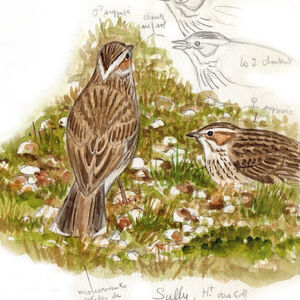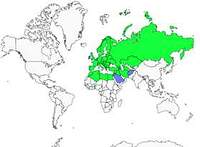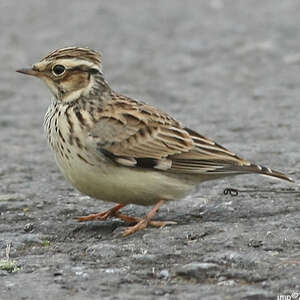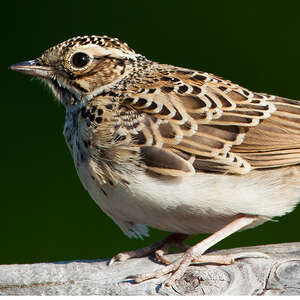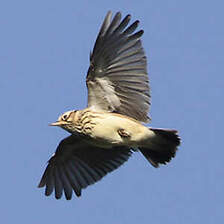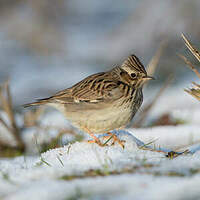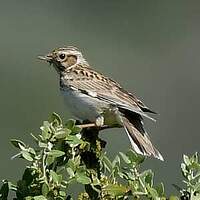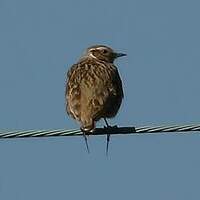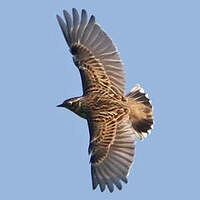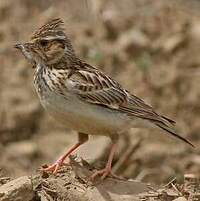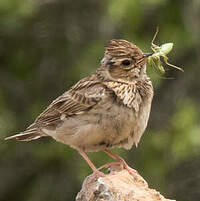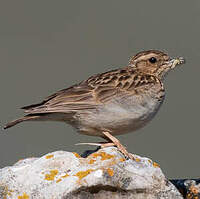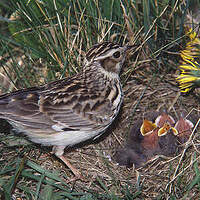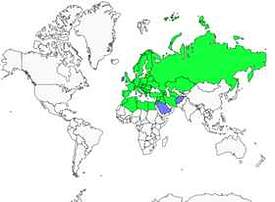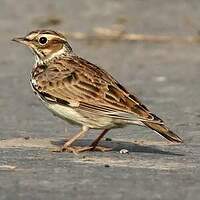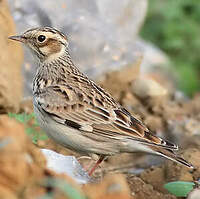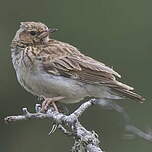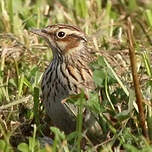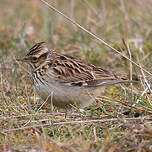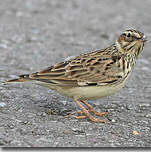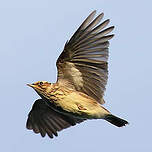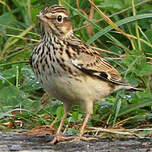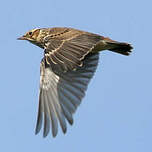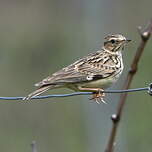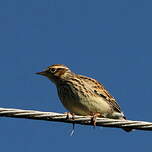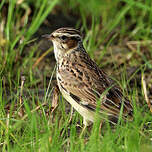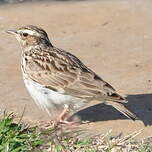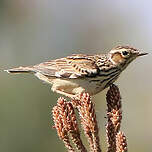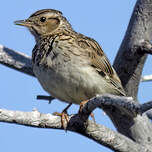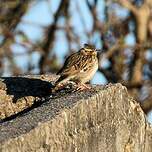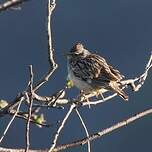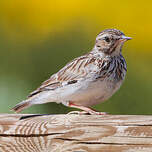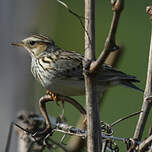Woodlark
Lullula arborea - Alouette lulu
Identification
The Woodlark is a bird that is identified according to the circumstances by its silhouette, plumage and voice. It is smaller than the Meadow Lark and more compact. By comparison its wings are wider and more rounded. Its tail is clearly shorter and the white is at the tip not on the outer edges. Regarding its plumage it is necessary to look at the head which shows clear white eyebrows that join together on the neck and reddish-ochre ear coverts, usually with a light patch under the eye. Then one should take interest in the wing edge at the hand level where the characteristic insignia of the species is found. The alula is largely whitish and just behind are black primary coverts with white at the tip, this giving a visible longitudinal "white-black-white" insignia. Its voice will be dealt with in the next chapter. One may also note a thinner beak, pink at the base of the lower mandible, and a more elongated posterior claw.
Otherwise the plumage is rather similar. Upperparts brown with blackish-brown streaks. Underparts cream white with blackish-brown streaks, fine on the chest and indiscernible on the flanks. On the other hand, from underneath in flight, the aspect is very different to that of the Meadow Lark. The dark remiges contrast with the white coverts and the black tail with white tip contrasts with the white undertail coverts.
The juvenile has the tectrix of the head, mantle and back as well as the alar and tertiary coverts dark-brown with a wide beige-ochre border and white tip. This gives the head a mottled look and the upperparts a scaly look. Its head pattern is more noticeable. Thus it can be seen more clearly than the adult's the black moustache, white sub-moustache and black malear line bordering the white throat.There is no sexual dimorphism. The pallida subspecies from Southern Europe is a slightly paler and grayer.
Subspecific information 2 subspecies
- Lullula arborea arborea (n, w and c Europe to w Russia and Ukraine)
- Lullula arborea pallida (s Europe and nw Africa through the Middle East to Iran and Turkmenistan)
Foreign names
- Alouette lulu,
- Alondra totovía,
- cotovia-dos-bosques,
- Heidelerche,
- erdei pacsirta,
- Boomleeuwerik,
- Tottavilla,
- trädlärka,
- Trelerke,
- škovránik stromový,
- skřivan lesní,
- Hedelærke,
- kangaskiuru,
- cotoliu,
- Trjálævirki,
- lerka,
- sila cīrulis,
- hribski škrjanec,
- Лесной жаворонок,
- モリヒバリ,
- 林百灵,
- trädlärka,
- 木百靈,
Voice song and call
The Woodlark's song consists of repeated notes whose tone decreases towards the end, giving an impression of melancholy. The most classic tune is lululululu..., from which the species gets its name. Notes may differ from moment to moment and from male to male. There are many variations such as tiu tiu tiu...wuitu wuitu wuitu...Tui Tui Tui...lulululululu...pipipipipi...tututututu...pli pli pli yutu yutu yutu etc. It can sing at night in quiet weather.
The contact call is a bi- or trisyllabic modulated and melancholy sound, like duliu, diwu, or other similar sounds. The flight call is of the same type, like diliu diTuitu and its variants. It can be easily heard by the ear.
Habitat
The Woodlark occurs in open and semi-open habitats, natural or disturbed, on well-drained soils with low and scattered herbaceous cover, from sea level to 2000 m altitude (higher in North Africa).
Behaviour character trait
The Woodlark has most of its activity on the ground, but if it is compared to the Skylark which rarely perches on a stake, bush or another low perch, it rather perches regularly even on high ground.
In particular in case of disturbance and therefore danger for it, it can go and perch at the top of a tree, on a high rock, on an electric or telephone wire, etc. Moreover its Latin name is Lullula arborea, that is to say the lulu of the trees.Another character trait, but shared by many species of birds, is the post-breeding inter-nuptial gregariousness which appears. The lulus stay in family groups during the summer and then gather in small troops for post-breeding migration in September-October. On the wintering grounds, it can always be found in groups, feeding on the ground. It can also meet with the Skylark.
Flight
Dietfeeding habits
The Woodlark looks for its food on the ground or in low herbaceous vegetation. Its diet is mixed, being both granivorous and insectivorous.
During the fine season, insects prevail, especially caterpillars, beetles, diptera, as well as spiders and other invertebrates, which is what the young are exclusively fed on. But it also consumes a great number of seeds, small shoots and other plant items. It could almost be qualified as an omnivore.Of course, in the bad season, it's the opposite, with the seeds dominating, but as the majority of birds migrate to southern regions where it does not freeze and the sun often appears, invertebrates stay active and can still be consumed.
Reproduction nesting
The Woodlark is monogamous and territorial in spring. The breeding season starts in March in the south, in April and May further north, and ends in July.
It has enough time to raise two successive broods. As soon as he arrives, the male sings to define and defend his territory. He does so by hovering and singing in flight, then dropping to the ground or perching on a perch. The female then clears a nest site, aided by the male, often at the foot of a protruding element of the site, such as a stone, bush, small tree or tuft of grass. The nest is made of dry plant elements, such as stems and grass leaves, and other available materials, all well integrated into the ground. The cup is lined with fine, well-pressed plant elements. The female lays 3-5 eggs, which she incubates for 12-15 days. The young are fed at the nest for 10-12 days. They leave it before they learn to fly, 3-4 days later. They will remain on the site until a possible second brood. This is how, already in summer, family groups are observed which prelude the more important pre-migratory gatherings at the end of the season.Geographic range
The Woodlark nests in Europe in temperate and Mediterranean climates, extending up to the Ural Mountains in Russia. To the north, it can only be found in the extreme south of England, Sweden, and Finland. To the south, it is a resident, usually at higher altitudes, in the Maghreb, the Middle East, Asia Minor, around the Black Sea, the Caucasusregion, and Iran south of the Caspian (Mts Elbourz) and up to the Persian Gulf around the Zagros Mountains. Birds in the north of the range (northern Europe, Russia) and from the east (central Asia Minor and Caucasus and Persian regions) are migratory and spend the winter around the Mediterranean and to the west of the Black Sea. Birds from the north and north-east of France do not occur in winter.
Threats - protection
Sources of information
- IOC World Bird List (v14.2), Gill, F and D Donsker (Eds). 2024-04-18.
- Les passereaux d'Europe, tome 1, P. Géroudet, M. Cuisin
- Avibase, Lepage Denis
- Birds of the World, The Cornell Lab of Ornithology
- xeno-canto, Sharing bird sounds from around the world,
Other sources of interest
 Specification sheet created on
21/07/2023 by Jean François
Specification sheet created on
21/07/2023 by Jean FrançoisTranslation by AI Oiseaux.net
© 1996-2025 Oiseaux.net
- Accipitriformes
- Aegotheliformes
- Anseriformes
- Apodiformes
- Apterygiformes
- Bucerotiformes
- Caprimulgiformes
- Cariamiformes
- Casuariiformes
- Charadriiformes
- Ciconiiformes
- Coliiformes
- Columbiformes
- Coraciiformes
- Cuculiformes
- Eurypygiformes
- Falconiformes
- Galliformes
- Gaviiformes
- Gruiformes
- Leptosomiformes
- Mesitornithiformes
- Musophagiformes
- Nyctibiiformes
- Opisthocomiformes
- Otidiformes
- Passeriformes
- Pelecaniformes
- Phaethontiformes
- Phoenicopteriformes
- Piciformes
- Podargiformes
- Podicipediformes
- Procellariiformes
- Psittaciformes
- Pterocliformes
- Rheiformes
- Sphenisciformes
- Steatornithiformes
- Strigiformes
- Struthioniformes
- Suliformes
- Tinamiformes
- Trogoniformes

